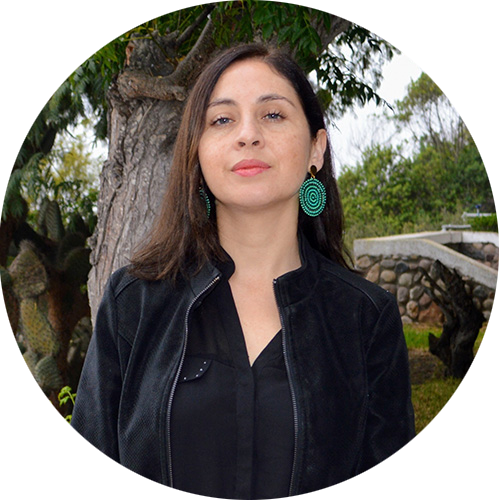Dra. Roxana González
 Correo electrónico: roxana.gonzalez@ceaza.cl
Correo electrónico: roxana.gonzalez@ceaza.cl
Línea de investigación: Microbiología e inmunología Aplicada a Recursos Marinos
Fono: 51 2 205973
Dirección oficina: Laboratorio FIGEMA, Larrondo 1281, Campus Guayacán, Universidad Católica del Norte, Coquimbo, Chile.
Descripción de investigación: Mi investigación se enfoca en desentrañar las complejas interacciones entre los microorganismos y sus hospedadores marinos, con un enfoque integral en la salud animal. Me interesa comprender cómo las variables ambientales afectan la dinámica entre patógenos y hospedadores, influenciando la virulencia de los patógenos, su distribución geográfica y la respuesta inmune de los organismos. Mi objetivo es aportar al conocimiento de la salud animal, abarcando desde el monitoreo preventivo de patógenos emergentes y el desarrollo de herramientas para su detección temprana, hasta la investigación sobre el uso de probióticos y la optimización de la respuesta inmune de los hospedadores.
X
Proyectos:
- Proyecto Postdoctorado FONDECYT 3220568: Efecto de la intensidad de las surgencias asociadas al cambio climático sobre la interacción hospedador-patógeno en el ostión Argopecten purpuratus. ¿Incrementa el riesgo de infecciones que puedan afectar su productividad acuícola?
- Proyecto Fondef ID21I10117: Plan de Vigilancia Sanitaria para la detección temprana de enfermedades emergentes en Mytilus chilensis, utilizando técnicas de diagnóstico histopatológicas y moleculares.
- Proyecto Postdoctorado MINEDUC UCN-19101 N°0001: Desarrollo de herramientas moleculares para la detección de bacterias potencialmente simbióticas y patógenas en Argopecten purpuratus.
X
Publicaciones:
- González R., Henríquez-Castillo C., Lohrmann K., Rojas R., Mercado A., Lira G., Brokordt K. Impacts of climate-driven upwelling intensification on scallop microbiota and health. Aquaculture 588 (740906).
- Muñoz-Cerro K., Gonzalez R., Mercado A., Lira G., Rojas R., Yáñez C, Cuadros F., Oyanedel D., Brokordt K., Schmitt P. 2023. Scallop larvae resistant to a pathogenic Vibrio harbor host-associated bacteria with probiotic potential. Aquaculture. 579 (740217). https://doi.org/10.1016/j.aquaculture.2023.740217.
- González R., Henríquez-Castillo C., Lohrmann K., Romero María Soledad, Ramajo L., Schmitt P., Brokordt K. 2022. The Gill Microbiota of Argopecten purpuratus Scallop Is Dominated by Symbiotic Campylobacterota and Upwelling Intensification Differentially Affects Their Abundance.. Microorganisms, 10, 2330. https://doi.org/10.3390/microorganisms10122330
- González R., Gonzalez D., Stambuk F., Ramírez F., Guzman F., Mercado L., Rojas R, Henríquez C., Brokordt K. Schmitt P. 2022. A g-type lysozyme from the scallop Argopecten purpuratus participates in theimmune response and in the stability of the hemolymph microbiota. Fish and Shellfish Immunology 123: 324–334.
- González, R., Coba de la Peña, T., Cárcamo, C., Brokordt, K. Molecular characterization and expression patterns of peroxiredoxin V (PrxV) from the scallop Argopecten purpuratus after Vibrio splendidus challenge. 2021. Aquaculture Reports.
- González, R., Gonçalves, A., Rojas R., Brokordt K., Rosa, D. y Schmitt, P. 2020. Host Defense Effectors Expressed by Hemocytes Shape the Bacterial Microbiota From the Scallop Hemolymph. Frontiers in Immunology 11:1-13.
- González, R., Brokordt, K., Rojas, R., Schmitt, P. 2020. Molecular characterization and expression patterns of two LPS binding /bactericidal permeability-increasing proteins (LBP/BPIs) from the scallop Argopecten purpuratus. Fish and Shellfish Immunology. 97: 12-17.
- Flores-Herrera,P., Farlora, R., González, R., Brokordt, K., Schmitt, P. 2019. De novo assembly, characterization of tissue-specific transcriptomes and identification of immune related genes from the scallop Argopecten purpuratus. Fish and Shellfish Immunology 89 505-515.
- González, R., Muñoz K., Brokordt K., Schmitt P. 2019. Scallop Immunology. Reference Module in Life Sciences. doi:10.1016/B978-0-12-809633-8.20896-0.
- González, R., Brokordt, K., Cárcamo, C., Coba de la Peña, T., Oyanedel, D., Mercado, L., Schmitt, P. 2017. Molecular characterization and protein localization of the antimicrobial peptide big defensin from the scallop Argopecten purpuratus after Vibrio splendidus challenge. Fish and Shellfish Immunology 68: 173-179
- Brokordt, K., González, R., Farías, W., Winkler, F., Lhormann, K. 2017. First insight into the heritable variation of the resistance to infection with the bacteria causing the withering syndrome disease in Haliotis rufescens abalone. Journal of Invertebrate Pathology 150: 15-20.
- Oyanedel, D., Gonzalez, R., Brokordt, K., Schmitt, P., Mercado, L. 2016b. Insight into the messenger role of reactive oxygen intermediates in immunostimulated hemocytes from the scallop Argopecten purpuratus. Development and Comparative Immunology 65: 226-230.
- Oyanedel, D., Gonzalez R., Flores-Herrera, P., Brokordt K., Rosa R., Mercado, Schmitt, P. 2016a. Molecular characterization of an inhibitor of NF-kB in the scallop Argopecten purpuratus: First insights into its role on antimicrobial peptide regulation in a mollusk. Fish & Shellfish Immunology. 52:85-93.
- Brokordt, K., González, R., Farías, W & Winkler, F. 2015. Potential response to selection of HSP70 as a component of innate immunity in the abalone Haliotis rufescens. Plos One 10(11): e0141959. doi:10.1371/journal.pone.0141959.
- Brokordt, K., Winkler, F., Farías, W., González, R., Castaño, F., Fullsack, P., Herbinger, C. 2015. Changes of heritability and genetic correlations in production traits over time in red abalone (Haliotis rufescens) under culture. Aquaculture Research. 46 (9): 2248-2259.
- González C. R., Lohrmann K, Pizarro J. & Brokordt.2014. Differential susceptibility to the Withering Syndrome agent and renal coccidia in juvenile Haliotis rufescens, Haliotis discus hannai and the interspecific hybrid. Journal of Invertebrate Pathology.116:13-17.
- González C.R., Brokordt K. & Lohrmann K. 2012. Physiological performance of juvenile Haliotis rufescens and Haliotis discus hannai abalone exposed to the withering syndrome agent. Journal of Invertebrate Pathology. 111:20-26.
Publicaciones:
| Institución ▲/▼ | Título Original ▲/▼ | Año ▲/▼ | Palabras clave | Referencia APA | Link al documento |
|---|